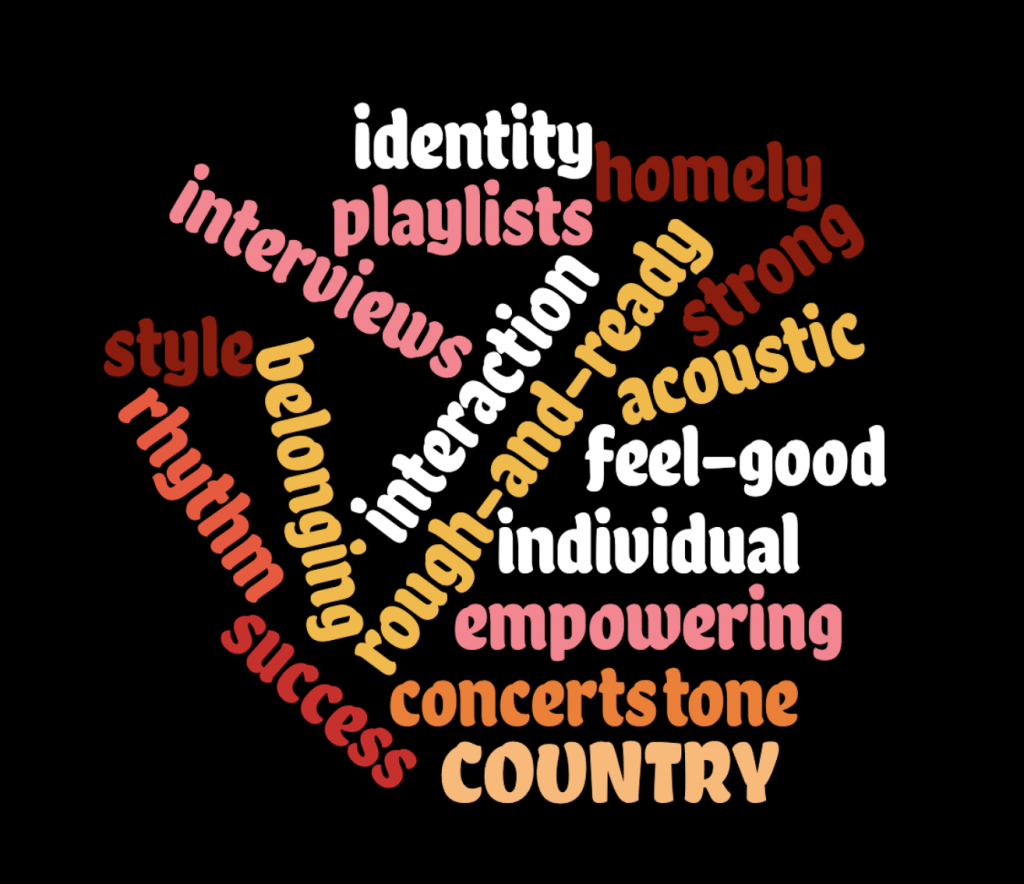In the presentation below, you can see my research into other country music magazines. I have described what they include, who they interview and how they communicate with their audiences. I have also then set out some aims for my own magazine; Roots, and what I would like to include to be conventional of the genre but unique at the same time in order to gain an audience.
Category: Music Magazine
Star Image – theirs and mine
In order to prepare for designing my star I have researched the star image of a famous country singer, Carrie Underwood. I looked into all the components that piece together to convey her star image including her music, performance, PR appearances, magazine covers and social media. This overall construction of a star is called a meta narrative.
Using Richard Dyer’s theory of the paradox of the star, it is clear that this applies to Underwood’s image as well. He said that these stars appear extraordinary (talented, amazing) and at the same time ordinary (they go shopping, fail driving tests etc). Dyer also stated that they are both present (eg. with social media we are able to interact with them) and absent (eg. during concerts on stage).
Below is my Prezi, which goes into detail about the meta narrative of Carrie Underwood.
Using inspiration from other female country singers I have constructed a look for my cover model. I am planning to have one female cover star. My star will pose with a smile on her face and relaxed, open body language to portray her friendliness and the idea of a ‘girl next door.’ I am aiming for my star to come across as talented, strong and unreachable, whilst at the same time conveying she is ordinary, friendly and honest.
Communicating my Brand
I have made a moodboard, full of ideas, colours, layouts, models and typography to refer back to when constructing my magazine. This is going to be very helpful when I’m constructing my magazine, when I get a mental block and I’m stuck for inspiration.
My Audience Profile
Here is a dating profile I constructed, using ratings and correlations on You Gov, to reveal my target audience’s demographics and psychographics.
I will aim to produce media that encodes ideas relevant to my target audience so if my country music magazine is successful they will decode this effectively. This is called preferred reading, however if this isn’t achieved and the audience rejects the values and ideas I encode in my magazine, this is called oppositional reading.
Something else I have achieved from this task is understanding what my readers will get out of consuming my magazine. This helps me to understand their uses and gratifications of the media I will produce, using Blumler and Katz‘ ideas. Hopefully, using my audience research, I will be able to produce a country music magazine that entertains and informs my audience as well as giving them something to identify and interact with.
Branding Ideas + Mission Statement
For my music magazine I have chosen the genre, country. I personally enjoy listening to country music as I love the tone of the genre and how it makes you feel.
I decided to call my magazine; ‘Roots’ because it has a homely feel and an earthy and rough vibe which are both conventional feelings from country music.
Below you can see the word cloud I created for the connotations of the country genre, that will help me to construct my mission statement for my magazine.
If I successfully include these items eg. interviews, playlists etc. and convey the themes of the genre then I should satisfy Blumler and Katz’ ideas about the uses and gratifications of media.
Mission statement: “Roots is devoted to spreading the love of the new age of country. By featuring up and coming country artists, the best new songs to inspire your playlists and introducing ways for you to get involved it aims to spark interest in the new age of country listeners and prove that country can be fun too.”
A Front Cover Analysed
After analysing audiences in the previous task we had to combine those skills with textual analysis also. By doing this I was able to see how producers of these magazines design them to target their audience.
For the magazine below, the target audience were middle-aged men. I was then able textually analyse the front of this magazine to explain in detail why the font, colour palette, images and language were chosen to suit the audience.
Audience Profiling
We had to study the audience of a magazine in great detail. I studied UNCUT, which is a classic rock magazine. The audience profile below include the readers demographics (age, gender, social grade etc.), psychographics (interests, segmentation etc.) and a list of all other common interests their readers have eg. politics and a TV programme called Narcos.
This task has been really helpful as it has enabled me to understand what makes up an audience and how to gather information to find your target audiences’ common interests. This will be important when considering my target audience for the music magazine I will be producing. After audience profiling I will be able to create a magazine that caters to my target audience the best it can.
Conventional design features of a magazine
After labeling the technical conventions of the front page of a magazine I am now aware of the expectations of my own magazine cover. Some of these typicalities include:
- Masthead
- Main cover line
- Main cover star
- Cover lines
- Pug
- Plug
- Inset
- Barcode and price
- Issue date
Below is an example of a magazine cover and we have labelled these technical conventions.



